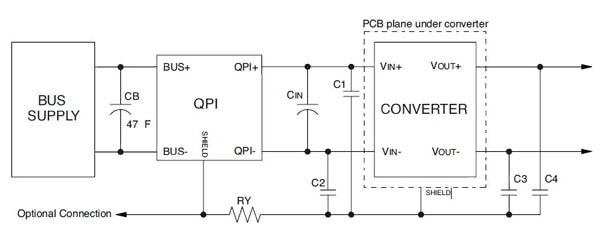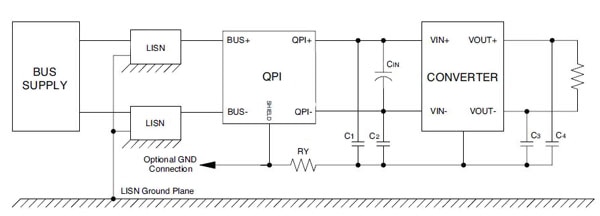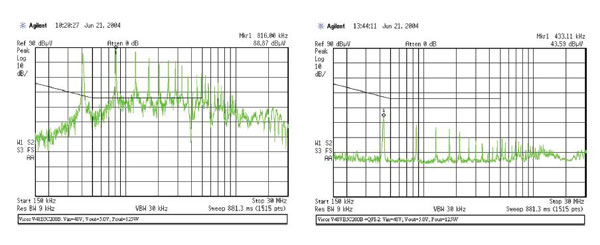Active Filters Control EMI, Save PCB Space, and Enhance Airflow
投稿人:DigiKey
2014-04-02
As spaces shrink, the potential for interference increases
The trend toward smaller devices with more functionality in smaller spaces continues unabated in the electronics industry. As spaces shrink, the potential for interference between devices increases as systems fit more functions in densely packed boards and racks. As frequencies rise and voltage levels fall, the control of conducted EMI becomes an even more important design task.
EMI control, a complex design task that is highly dependent on many design elements, makes use of filters, both passive and active, to manage conducted noise. Active EMI filters, in contrast to passive solutions, reduce the volume of the common-mode choke — allowing the filter to be packaged in a 1" x 1" x 0.2" package — and provide a low-profile, surface-mount device. The smaller size saves valuable board real estate, and the reduced height enhances airflow for better heat management.
Active EMI filters (labeled QPI in Figure 1) attenuate conducted-mode and differential- mode noise over the frequency range of 150 kHz to 30 MHz required by conducted emissions standard EN55022 (CISPR22). Figure 2 shows before and after plots of a DC-DC converter noise profile to demonstrate the performance of an active filter. The plots were taken using the standard measurement technique, and were set up as defined in CISPR22. The results show the total noise spectrum for a standard DC-DC converter under load, compared to the EN55022 Class B Quasi-peak detection limit. The plot shows that an active filter is effective in reducing the total conducted noise spectrum to well below the required limits.

Figure 1: Typical diagram for an active EMI filter (labeled QPI) for a DC-DC converter. The values of CIN and C1, C2, C3 and C4 are those normally recommended by the converter manufacturer.
Figure 2: Conducted EMI profiles of a DC-DC Converter with no filter (left) and with an active EMI filter (right).
Designers should be aware that to select and qualify an EMI filter for conducted noise, they must test the filter in their product under the setup and conditions specified in the applicable EMI standards. Filter selection or design must be based on the pre-filtered noise magnitudes and the frequency spectrum of concern. A product's conducted noise profile includes differential and common-mode noise. It may also include radiated noise depending on the EUT shielding and cabling screening in the measurement setup. The IEC (International Electro-technical Commission) specification CISPR 16-2-1 describes the methods of measurement for conducted disturbances.
Filter performance in the application is highly dependent on the input bus and load impedance and cannot be extrapolated from zero bias 50 Ohm insertion loss data alone. Final noise performance is a complex function of filter elements, equipment grounding, and noise source impedances, which vary in magnitude and phase over the frequency spectrum of interest.

Figure 3: Spectrum analyzer test setup (QPI and converter 5 mm above ground plane).
The active EMI filters provide active common-mode attenuation of conducted noise over the EN55022 range from 150 kHz to 30 MHz. This is achieved by sensing the common-mode current flowing in the bus lines and creating low impedance at the shield plane to re-circulate the noise back to the generating source. When connected as shown in Figure 1, the control loop will actively drive the shield pin and will reduce the common-mode current in the bus lines to values approaching the common-mode current ratio attenuation curve in Figure 2.
The first step in designing to meet conducted emissions standards is to minimize the noise generators. The conducted noise sources measured on the supply bus and reference ground within a system are most often caused by the power conversion section and, to a lesser degree, other sources such as data I/O lines or PWM fan motor driver circuits.
With brick-type converters, certain topologies and manufacturers generate less noise than others. Knowledge of the converter's base-line noise is critical. The next step is to minimize the noise sources' coupling paths to the power sources. Most manufacturers of DC-DC converters recommend decoupling their products with passive components and shielding via PCB ground planes. Even the best low noise converters usually require additional filtering and decoupling to pass compliance testing, especially the EN55022 Class B limit.
The two components of conducted noise are differential and common mode. Differential-mode noise is created on the power bus by the AC component of input differential current caused by the changing input current the converter presents to the bus supply providing the input power. The differential-mode current created is what is defined as symmetrical voltage in CISPR 16-2-1.
Most converter manufacturers specify a minimum input capacitance (Cin) to provide low input source impedance for stable operation. Recommended large-value electrolytic capacitors do not have low impedance at the harmonic frequencies of the converter fundamental. Therefore, low value capacitors with good high frequency characteristics should be connected in parallel with the electrolytic input capacitors. Even with this approach, some differential AC current will flow from the bus, causing differential-mode noise currents in the bus lines.
To meet the lowest level of the Class B specification, the differential current in the conduced EMI frequency range should be less than 21 dBμA. This equates to 55 dBμV or 562 μV of rms voltage across 50 Ohms. The length of bus lines can vary depending on system installation. To mitigate the effects of this variable, the capacitor CB (Figure 1) should provide a low source impedance to the QPI, thus minimizing input excursions during transient loads reflected from the output of the converters to the QPI. The bus line parasitic inductance and CB form additional filtering for differential noise current.
Common-mode noise on the power bus is defined as an unsymmetrical voltage in CISPR 16-2-1. CISPR 16-2-1 also describes common-mode disturbances as those primarily measured for signal and control lines. The active filter is designed to solve common-mode noise problems on the power bus.
High dv/dt E fields (usually at the primary switch), secondary rectifiers, and power transformer parasitic capacitance are causes of common-mode noise. B fields of the power magnetics and parasitic inductances caused by high levels of dl/dt in the converters are also a common-mode noise source. All noise currents generated by these high fields must return to their source. Best practice for the E fields is to provide return path with capacitors — usually referred to as "Y" caps — through a common-shield ground plane.
For compliance testing, the ground plane of the Line Impedance Stabilization Network (LISN) provides the return path as shown in the test circuit in Figure 3. In compliance testing, the common-mode currents flow through the LISN's 50 Ohm measurement paths of the bus+ and bus-, returning to their source in the equipment-under-test (EUT) via the wires connecting the LISN to the EUT.
The CISPR22 test limits are for total noise over the specified spectrum for a particular system. Both differential- and common-mode noise components can cause compliance failure, and generally both must be attenuated to pass the Class B limit. The class distinction details will not be covered here, but essentially, Class A permits higher noise levels, typically in fixed systems, as compared to those allowed in Class B for general consumer and portable applications. The standard for fixed systems has recently been raised to the Class B conducted noise limit in the AdvancedTCA™ PICMG® 3.0 requirements for individual data communications boards.
There are also different detection techniques that affect the limits used for the pass/fail criteria. The EN55022 quasi-peak detection Class B limit is the limit line in all plots in this article.
Conclusion
The results shown in this document were obtained with the test configuration shown in Figure 3. The peak detection option of the spectrum analyzer was used instead of quasi-peak for dramatic reduction in the sweep time of the analyzer. Using the quasi-peak detection measurement mode would result in lower measured amplitudes by the factor this detection method introduces.

免责声明:各个作者和/或论坛参与者在本网站发表的观点、看法和意见不代表 DigiKey 的观点、看法和意见,也不代表 DigiKey 官方政策。









